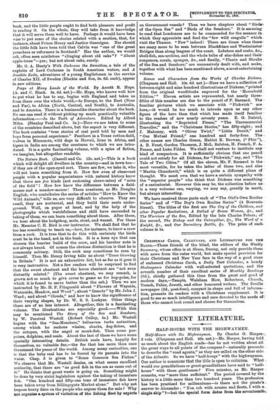CURRENT LITERATURE.
HALF-HOURS WITH THE HIGHWAYMEN.
Half-Hours with the Highwaymen. By Charles G. Harper.--, 2 vols. (Chapman and Hall. 428. net.)—Mr. Harper, having told us much about the English roads—has he not written about all the great ways to all points of the compass ?—naturally proceeds to describe the "road agents," as they are called on the other side of the Atlantic. So we have "half-houss" with the highwaymen. Our author is conscious that the title is open to criticism. What , would our grandfathers or great-grandfathers have said to "half- hours" with these gentlemen ? Five minutes, as Mr. Harper remarks, was "more than sufficient." The period covered by the history is a little more than two hundred years. The profession has been practised for millenniums—is there not the pirate's , answer to Alexander : "You rob with armies and fleets, I with a. single ship "P—but the special form dates from the seventeenth..
'century. The roll begins with Gamaliel Ra.tsey, who was hanged on March 28th, 1605; but Mr. Harper thinks that, though there was a person of the name who suffered in this way, the adventures are apocryphal. In chap. 2 we go back, why it is not easy to say, to Robin Hood; in chap. 4 we take up the subject proper, making a dignified beginning with John Popham, after- wards Lord Chief Justice. In his youth, says Aubrey, he would "take a purse" with his wild companions. But then Aubrey was not strictly truthful. A long list of the heroes follows. Perhaps the most famous are Claude du Vail and Dick Turpin. As to Dick Turpin, our author, though he does not bind himself to a rigid criticism of the narratives he deals with, feels con- strained to disenchant us. He was not the hero that has been pictured; first and foremost, the famous ride to York disappears. Still, he will probably remain tho princa of highwaymen to the end. There is plenty of readable matter in the two volumes, and there are many well-chosen illustrations.

































































 Previous page
Previous page